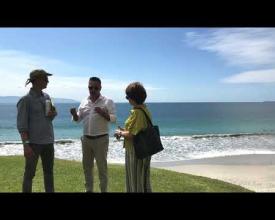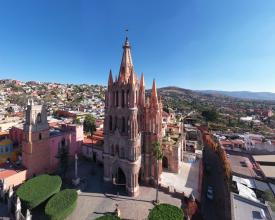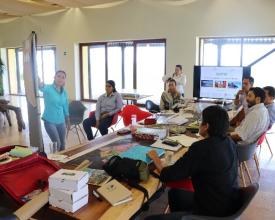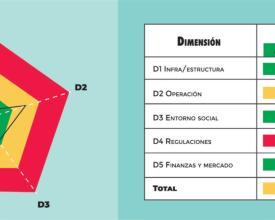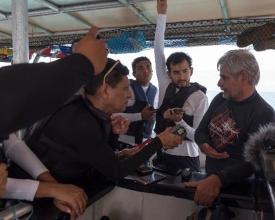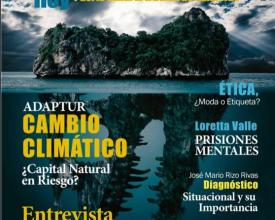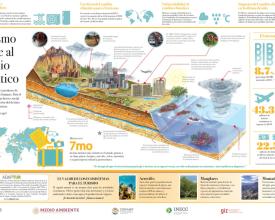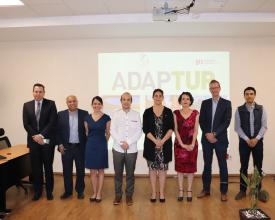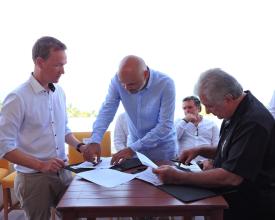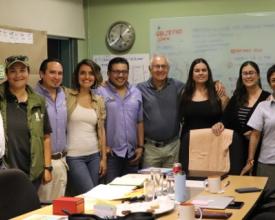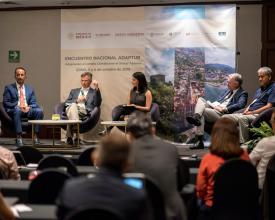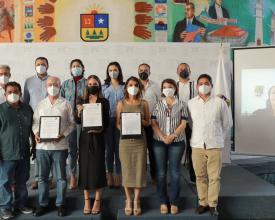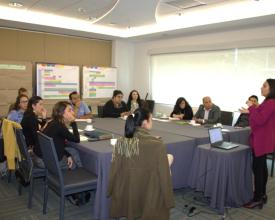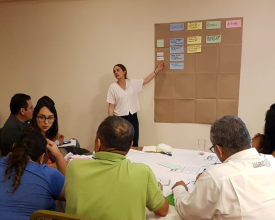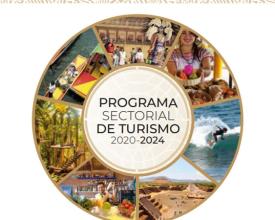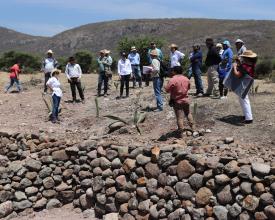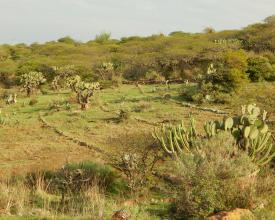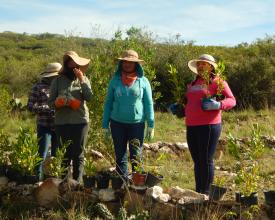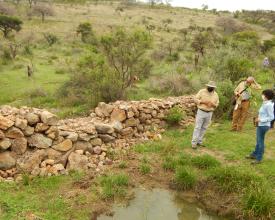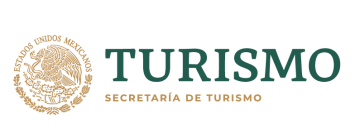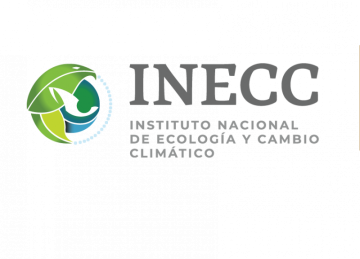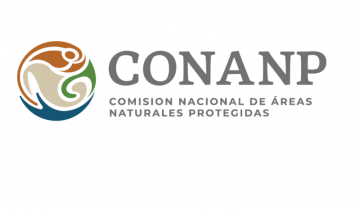
ADAPTUR: Mainstreaming Ecosystem-based Adaptation (EbA) in the tourism sector as a strategy for NDC implementation in Mexico

The main components of the project Ecosystem-based Adaption to climate change in the tourism sector (ADAPTUR) are: economic risk analysis, communication strategy, strengthen public and private sector cooperation, capacity building, planning and implementation of EbA solutions with the participation of all relevant stakeholders (handmade dams and forest restoration to reduce vulnerability to droughts), mobilizing finance from public and private sector, as well as policy development on the national and regional level.
ADAPTUR is financed by the German Ministry of Environment (BMU) and implemented by the Deutsche Gesellschaft für Internationale Zusammenarbeit (GIZ) GmbH in cooperation with the Mexican Ministry of Tourism (SECTUR), the Mexican Ministry of Environment (SEMARNAT), the National Commission of Natural Protected Areas (CONANP) and the Institute of Ecology and Climate Change (INECC). The project was implemented in three leading Mexican tourism destinations.
Context
Challenges addressed
The tourism sector in Mexico is strongly affected by climate change. With sea levels rising, coastal destinations run the risk of losing their beaches and thus one of their main tourism attractions. They also suffer from more severe hurricanes and flooding, which is not only bad for business, but has started to impact local real estate value. Coral reefs are suffering from rising temperature, which poses pressure on their diverse flora and fauna and the local diving industry. Inland destinations on the other hand, are suffering from droughts and a decline in water supply, which impacts local economies and leads to social conflicts.
Location
Process
Summary of the process
The first step was to better understand the situation, attitude, and capacities of the main target audience: the private sector. For that, we conducted a KAP analysis which delivered input for our communication and capacity building strategy (Block 2). At the same time, we conducted an economic risk assessment to quantify the costs of climate change for our tourism destinations and to put a price-tag on climate change (Block 1). Once we had the private sector's attention, the next step was to strengthen cooperation structures through creating trust between public and private actors (Block 3). During this period, a communication strategy was executed to raise public awareness of climate change risks, meanwhile a capacity building strategy with focus on the development of policies and EbA solutions was implemented (Block 2).
On the national and subnational levels, we supported the development of new tourism policies which included climate change and EbA criteria (Block 4). All of the above led to the planning and implementation of EbA measures, which were funded by the public and private sectors and implemented by civil society organizations and local communities (Block 5).
Building Blocks
B1: Setting a price tag on climate change for the involvement of private sector in Ecosystem-based Adaptation
Traditionally, climate change has been conveyed as an environmental and scientific concept. But since its impact on industries and productive sectors has become more and more apparent, there is an urgent need to better understand the economic dimension of climate change and its financial risk for the decision-making of the private sector.
Translating environmental risks into business risks also helps to draw the private sector's attention. Therefore, the project ADAPTUR performed an economic risk assessment in three of its project destinations to calculate the future costs of climate change for the tourism industry. Additionally, a handbook on climate-proof investment was published, which was developed with inputs and participation of the private sector, especially during the design of methodology. One of the conclusions was that adaptation would be a good investment because by making businesses more resilient to climate change, it is possible to reduce their future costs.
Enabling factors
- Translating environmental terms into business language: e.g., vulnerability = business risk; ecosystem = nature capital, etc., helps the private sector to get your message.
- Link climate change impacts to business risks and opportunities: since companies understand their business best, this should be very participatory.
- Understand how the private sector works: consider existing business processes as part of your solution.
- Create trust: involve private sector representatives from the beginning, be transparent in decision-making, and have clear expectations.
Lesson learned
- Understand business concepts (return on investment, business case, economic risk, etc.) and the way of thinking (time is money, resources are limited, etc.) when engaging with the private sector. It helps to include a member with private sector background in your team.
- Since industries have established business processes, it is essential to develop compatible solutions. In Mexico, new investments in tourism infrastructure follow a strict process. Therefore, ADAPTUR developed improvements easy to integrate into the existing process.
- The private sector has its own tools and methodologies (scenario modeling, risk assessment, cost analysis, etc.). In many cases it is better to build upon those tools instead of introducing a new methodology unknown to the industry.
- The private sector may consider specific data or information as sensitive, including financial data and specific project results because they may affect a company's reputation in its market. It is therefore important to have a mutual understanding of the information that is confidential or sensitive. Confidentiality agreements may help to formalize this understanding.
B2: Communication and capacity building strategy for climate action
The first step towards the development of a target group specific communication and capacity building strategy was a KAP analysis (knowledge, attitude, practices), which established a baseline, in terms of understanding the private sector´s knowledge about climate change, as well as its attitude towards the topic and the practices already in place. The analysis also included a capacity needs assessment, which served as input for ADAPTUR´s capacity building and training program. The findings were also used to train counterparts, consultants, and project members in better understanding the private sector and to improve their communication skills by using the right words, concepts and messages.
The training program comprised several topics about climate change vulnerability, climate-proof investment, cost-benefit analysis, national/subnational policies related to climate change, EbA solutions, public-private cooperation, financial mechanism, etc.
At the same time, a press campaign was launched in cooperation with local media and journalists. The ADAPTUR website was introduced with regular newsletters, best-practices, case studies and messages from industry leaders. It also contained a resources section with studies, tools and information material.
Enabling factors
- A good understanding of the industry context and the private sector´s challenges, priorities, needs and restrictions.
- Create attention by linking climate change with business interests.
- Recognition of private sector work culture and values (fast decision making, time is money, etc.). Offer cooperation and training formats that are suitable for the private sector.
- Cooperation with industry leaders, known journalists and lead consultants as change agents to position the relevance of adaptation for the sector.
Lesson learned
- Plan some time for understanding your target group and awareness raising before you initiate the first direct contact. Preparing the ground and being well prepared may save you time later.
- Work together with a professional agency to develop and implement your communication strategy.
- Identify possible change agents in the private sector that could motivate other businessmen/women to engage in the project.
- Encourage peer-to-peer dialogue and exchange between private sector actors to build a relationship, increase trust and learn from each other.
- Offer planning and training formats that are suitable for the private sector context and consider local needs and realities (e.g. business executives normally do not have time to participate in day-long participatory workshops).
- Recognize realities, limitations, concerns and existing risks for business leaders, entrepreneurs, and investors especially during pandemics like COVID-19 or other crises.
B3: Strengthen cooperation structures between public and private sector
Adaptation to climate change is a complex change and transformation process and needs good cooperation and coordination between the private and public sector who usually have different understandings, priorities, and work cultures. In many cases there is even a history of failed cooperation attempts and an underlying sense of mistrust or prejudice. To overcome those obstacles and to build a strong cooperation structure between its counterparts, ADAPTUR followed the Collective Leadership Model from the Collective Leadership Institute in Potsdam, Germany.
The model understands change as a longer process with several phases and includes key elements from creating a shared vision, building cooperation structures, consolidating agreements, and implementing learning mechanisms. The result was integration of smaller groups of well selected change agents of private, public and social sectors (so called “containers”) who show strong support for the envisioned change, act as first movers and at a later point in time motivate other actors in the sector to join the initiative or movement.
Enabling factors
- Deep understanding of issues, positions and relationships between key stakeholders and their history and past experiences with similar processes.
- Ability to act as a neutral agent and facilitator who can build bridges between different stakeholder groups and institutions.
- Create a vision of the future that is shared and supported by different project stakeholders (e.g., business leaders, government representatives, civil society leaders, academic experts).
- Capability to gain the trust of important sector leaders and to convince them to promote the project.
Lesson learned
- Creating a trustful relationship with the private sector is a long process that requires sensitivity and patience. Working with business leaders as change agents may be an excellent strategy to gain trust and initiate a change process "from within.". For example, ADAPTUR´s Regional Advisor helped to create relationships by facilitation meetings between the tourism industry, environmental organization and civil society.
- Scientific data is very important to build your case for adaptation. But as human beings we are also inspired, moved and motivated by emotions. In ADAPTUR we worked a lot with photos, videos, and stories to create an emotional connection with the project.
- Success is maybe the strongest motivator. It is important to have some quick wins at an early stage of the cooperation and to celebrate even smaller achievements with your project partners and target group.
- Change is a journey. Keep the actors updated and interested (newsletters, communication of best practices, intersectoral dialogues, workshops) and celebrate your achievements.
B4: Mainstreaming of Ecosystem-based Adaptation in tourism policies
Despite ecosystem health and the services they provide being crucial for the industry, they not always considered sufficiently in tourism development plans and policies. Therefore, ADAPTUR assigned one Technical Adviser to the Ministry of Tourism (SECTUR) and another one to the Ministry of Environment (SEMARNAT) to worked closely together and established cooperation structures which allowed to integrate aspects of biodiversity and climate change into national legislation.
One important result was the new Tourism Programme 2020-2024 PROSECTUR, which represents a major milestone in Mexico´s ambitions to fulfil its Nationally Determined Contributions (NDC) and to integrate ecosystem-based adaptation (EbA) into its sector plans. On the subnational level, one Regional Technical Adviser was also assigned to each of its three project destinations to provide permanent facilitation of local cooperation processes.
By doing this, several subnational policies and development plans which integrate EbA have been developed (e.g., Municipal Climate Plan Puerto Vallarta, Municipal Climate Plan Bahía de Banderas, Urban Development Plan San Miguel de Allende). Recently, policy proposals made by the Congress of Quintana Roo, and the initiative to mainstream the NDC and PROSECTUR goals in sub-national tourism policies have started.
Enabling factors
- Establishment of cooperation structures between the Ministry of Tourism and the Ministry of Environment.
- Permanent presence of Technical Advisors in the pilot regions (no fly-in/fly-out).
- Capacity building of key stakeholders on the national and regional level and from different sectors.
- Local media and press published many articles about tourism and climate change and influenced public opinion favorably.
- Industry leaders from public and private sector acted as change agents and promoted EbA as a solution.
Lesson learned
- Biodiversity or adaptation to climate change can easily be integrated into sector plans and polices if there is a communication bridge or cooperation structure between the respective government entities. These cooperation structures may probably need facilitation from a third party like GIZ or other facilitators that act as a bridge.
- Including the private sector into participatory multisectoral processes for the development of plans and policies remains a challenge due to different work cultures, short term goals and time restrictions. It is possible, but only if the project offers formats that are suitable for the private sector (focused, result oriented, executive style) or limits the interaction to specific decision points (versus participation during the whole process).
- Already at the planning stage of the project, it is important to consider government cycles and elections on the national and subnational level to avoid that promising policy development processes get cut off. On the other side, newly elected governments may offer good opportunities for new legislative initiatives.
B5: Implementation of EbA solutions with private sector financing
The implementation of EbA solutions is a result of a long process, where resources, knowledge, and leadership of different sectors are united by a common goal. Another crucial element is to have a financing mechanism that allowed the funding of proposed projects. To evaluate and prioritize different adaptation options in the three destinations, the project applied over 30 cost-benefit analyses and had several workshops with local technical experts.
As a result, in San Miguel de Allende for example, a new Green Fund was established by the Ministry of Environment that channeled private sector fees and contributions towards EbA measures. In addition, the money mobilized through the Green Fund was matched with money from an existing Program for Payments of Ecosystem Services (PES) run by the National Forestry Commission (CONAFOR).
Through this co-financing scheme, the city was able to implement five EbA solutions wich include handmade dams and forest restoration accordingly with level curves of the site to ensure sufficient drinking water in the future. All solutions were implemented with the cooperation of local NGOs (like Salvemos al Río Laja A.C.) and communities.
Because of the pandemic, the other proposed EbA solutions in the other sites were not implemented.
Enabling factors
- Trust and cooperation structures between several sectors: local municipalities, tourism industry leaders and civil society.
- Existence of leaders from the public, private and civil society sector that acted as change agents and joined forces united by a common goal.
- Presence of strong civil society organizations with a lot of technical experience in environmental projects.
- Existence of a financial mechanism that allowed to mobilize public and private funding for EbA measures.
Lesson learned
- Technical information should be followed by a communication strategy oriented to sensitize the private sector and promote multi-sectoral dialogue for the financing process.
- In addition to scientific data, it is helpful to create an emotional connection between decision makers and their natural capital. For ADAPTUR, one very successful strategy was to organize trips for business leaders to the countryside, where they could see negative climate effects to their homeland with their own eyes.
- Invest time in building trust and cooperation structures between local actors from different sectors that are important for the development of your project´s EbA solutions.
- Helping local actors to use successful EbA solutions to promote their work, organization or business creates another incentive for participation and may motivate other actors to join the project.
Impacts
- Awareness raising among industry leaders and decision makers in the tourism sector through a target group specific information and communication campaign (e.g. the publication of several articles about climate change impacts in local/regional media.
- Development plans, policies and regulations at both national and local levels include EbA and climate change approaches and are related to NDC implementation in Mexico (e.g. the Climate Plan of Puerto Vallarta incorporates EbA solutions like forest restoration to reduce vulnerability to flooding and landslides).
- Leading Mexican investors have integrated climate risks and ecosystem-based solutions into the planning process of their current tourism projects with the objective to make their investments more “climate-proof”.
- Implementation of several EbA solutions with contributions from the public and private sectors, which are implemented by NGOs and in cooperation with local communities. Those solutions brought environmental, social, and economic benefits, like improved water supply, restoration of habitat for wildlife, and temporary jobs for communities during the economic crisis of Covid-19.
Beneficiaries
Beneficiaries of ADAPTUR include partners from public authorities of the tourism and environmental sector on national and subnational levels, the private tourism industry, civil society organizations and local communities of the three selected destinations.
Sustainable Development Goals
Story
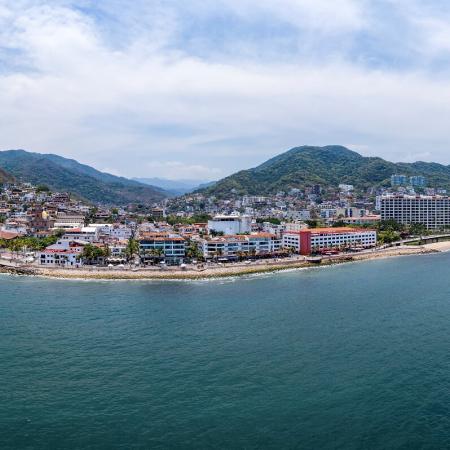
Extraordinary mountain range and bay
Carrying out business in a region such as the Riviera Nayarit and Puerto Vallarta implies recognizing that we depend on the mountains and the bay beyond the geopolitical territory.
In the Puerto Vallarta and Bahía de Banderas Business Association (AEBBA), for years, we have recognized that caring for nature is an essential part of social responsibility. Still, when we began to collaborate with the ADAPTUR project, we realized that the issue went further. We understood that considering the adverse effects of climate change, maintaining a good balance with nature and its ecosystems is not only a matter of competitiveness between tourist destinations but a matter of business survival.
We signed a Memorandum of Understanding (MoU) with ADAPTUR and participated in preparing the Municipal Climate Change Program of Puerto Vallarta. Hand in hand with experts, we were able to identify vulnerabilities and propose proposals to reduce risk at the destination.
Within the AEBBA, we created a Green Agenda Commission, headed by Captain Enrique Tron, to promote these issues among the members of our organization. As part of the activities, we collaborate with our data to prepare studies that help us understand the economic risk in tourist destinations due to climate change.
Similarly, this collaboration allowed us to promote the development of capacities among AEBBA partners on adaptation to climate change issues through workshops, conferences, meetings, videos, and other informational elements.
But it was not only information, we also accessed and distributed among our partners, relevant tools such as the "Climate Proof Investment Guide," which was even piloted by some of our members.
We are currently part of the Alianza Montaña-Bahía initiative, an important alliance with civil, academic, and government organizations. For the first time in the region, we have a portfolio of climate change adaptation projects with financial plans, the implementation of which would reduce the vulnerability that the marvelous mountains and the beautiful Bahía de Banderas currently have and their lively ecosystems.
Dr. Jorge Alberto Villanueva Hernández
President of the Asociación de Empresarios de Puerto Vallarta y Bahía de Banderas (AEBBA) A.C., Mexico

